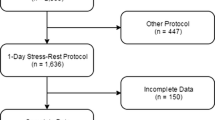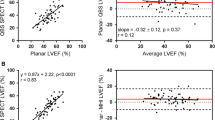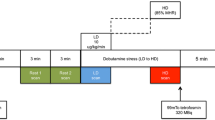Abstract
Aim
To evaluate the reproducibility of serial re-acquisitions of gated Tl-201 and Tc-99m sestamibi left ventricular ejection fraction (LVEF) measurements obtained on a new generation solid-state cardiac camera system during myocardial perfusion imaging and the importance of manual operator optimization of left ventricular wall tracking.
Methods
Resting blinded automated (auto) and manual operator optimized (opt) LVEF measurements were measured using ECT toolbox (ECT) and Cedars-Sinai QGS software in two separate cohorts of 55 Tc-99m sestamibi (MIBI) and 50 thallium (Tl-201) myocardial perfusion studies (MPS) acquired in both supine and prone positions on a cadmium zinc telluride (CZT) solid-state camera system. Resting supine and prone automated LVEF measurements were similarly obtained in a further separate cohort of 52 gated cardiac blood pool scans (GCBPS) for validation of methodology and comparison. Appropriate use of Bland-Altman, chi-squared and Levene’s equality of variance tests was used to analyse the resultant data comparisons.
Results
For all radiotracer and software combinations, manual checking and optimization of valve planes (+/− centre radius with ECT software) resulted in significant improvement in MPS LVEF reproducibility that approached that of planar GCBPS. No difference was demonstrated between optimized MIBI/Tl-201 QGS and planar GCBPS LVEF reproducibility (P = .17 and P = .48, respectively). ECT required significantly more manual optimization compared to QGS software in both supine and prone positions independent of radiotracer used (P < .02).
Conclusions
Reproducibility of gated sestamibi and Tl-201 LVEF measurements obtained during myocardial perfusion imaging with ECT toolbox or QGS software packages using a new generation solid-state cardiac camera with improved image quality approaches that of planar GCBPS however requires visual quality control and operator optimization of left ventricular wall tracking for best results. Using this superior cardiac technology, Tl-201 reproducibility also appears at least equivalent to sestamibi for measuring LVEF.



Similar content being viewed by others
References
Berman D, Germano G, Lewin H, Kang X, Kavanagh PB, Tapnio P, et al. Comparison of post-stress ejection fraction and relative left ventricular volumes by automatic analysis of gated myocardial perfusion single-photon emission computed tomography acquired in the supine and prone positions. J Nucl Cardiol 1998;5:40-7.
Schaefer WM, Lipke CS, Kuhl HP, Koch KC, Kaiser HJ, Reinartz P, et al. Prone versus supine patient positioning during gated 99mTc-sestamibi SPECT: Effect on left ventricular volumes, ejection fraction, and heart rate. J Nucl Med 2004;45:2016-20.
Bland JM, Altman DG. Statistical methods for assessing agreement between two methods of clinical measurement. Lancet 1986;1:307-10.
Reiber JH, Lie SP, Simoons ML, Hoek C, Gerbrands JJ, Wijns W, et al. Clinical validation of fully automated computation of ejection fraction from gated equilibrium blood-pool scintigrams. J Nucl Med 1983;24:1099-107.
Pfisterer ME, Battler A, Swanson SM, Slutsky R, Froelicher V, Ashburn WL. Reproducibility of ejection-fraction determinations by equilibrium radionuclide angiography in response to supine bicycle exercise: Concise communication. J Nucl Med 1979;20:491-5.
Slutsky R, Karliner J, Battler A, Pfisterer M, Swanson S, Ashburn W. Reproducibility of ejection fraction and ventricular volume by gated radionuclide angiography after myocardial infarction. Radiology 1979;132:155-9.
Vos PH, Pauwels EK, Vossepoel AM. Thallium myocardial perfusion scintigraphy: Influence of perfusion, scatter, and photon energy on the detection of lesions. Cardiovasc Intervent Radiol 1986;9:7-12.
Askew JW, Miller TD, Ruter RL, Jordan LG, Hodge DO, Gibbons RJ, et al. Early image acquisition using a solid-state cardiac camera for fast myocardial perfusion imaging. J Nucl Cardiol 2011;18(5):840-6.
Berman DS, Kang X, Tamarappoo B, Wolak A, Hayes SW, Nakazato R, et al. Stress thallium-201/rest technetium-99m sequential dual isotope high-speed myocardial perfusion imaging. JACC Cardiovasc Imaging 2009;2:273-82.
Disclosure
All authors have nothing to declare.
Author information
Authors and Affiliations
Corresponding author
Rights and permissions
About this article
Cite this article
Cherk, M.H., Ky, J., Yap, K.S.K. et al. Optimal reproducibility of gated sestamibi and thallium myocardial perfusion study left ventricular ejection fractions obtained on a solid-state CZT cardiac camera requires operator input. J. Nucl. Cardiol. 19, 713–718 (2012). https://doi.org/10.1007/s12350-012-9561-6
Received:
Accepted:
Published:
Issue Date:
DOI: https://doi.org/10.1007/s12350-012-9561-6




